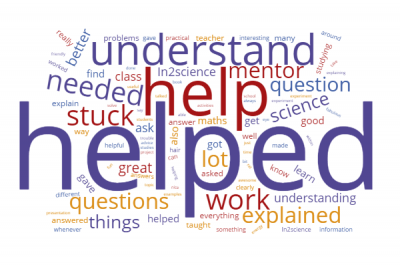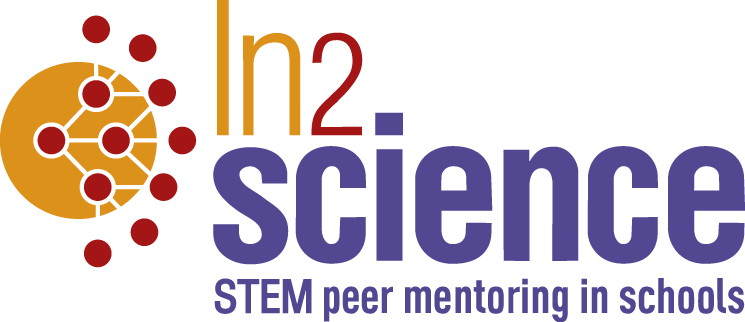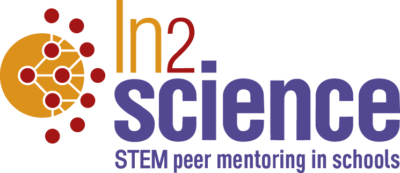Semester 2 heralded a significant milestone for the In2science program.
All four partner universities were active in placing mentors for the first time under new funding from the Federal Government’s Australian Maths and Science Partnership Programme. This funding saw the four universities:
- recruit, train and place 74 mentors
- reach 1646 students
- enable an annual contribution of $3.5 million to the Australian economy as the result of mentored students pursuing science, technology, engineering and mathematics careers
The long-term benefits of peer mentoring can be difficult to quantify. However, pre- and post-placement surveys allows glimpses of the short-term impact of the In2science program on both mentors and students.
Impact on students

Word cloud generated from students’ comments.
In2science mentors had a generally positive impact on students’ engagement with and attitudes towards science.
Preliminary analysis of survey results reveal that, after having an In2science mentor, students:
- Are more likely to discuss science with friends and other students in order to improve their understanding
- Remain relatively unchanged in their perception of science ability
- Are more likely to enjoy practical investigations
- Can see themselves doing a job that involves science
Students completed a pre-placement survey in July, which was followed up post-placement in October/November. Using an anonymous unique student identifier, we have matched a number of responses, allowing analysis of individual students and their change in responses.
This approach to evaluation has produced an astounding 29,500 individual data points and a myriad of ways to probe them. Investigating the number of students who changed their responses to survey questions from July to November – or those who remained unchanged – reveals general trends and impacts of In2science mentors on students at an individual level. As an example, 26% of students from matched data responded more positively to the statement “Nearly everyone is capable of understanding science if they work at it” after having an In2science mentor, while 66% remained unchanged. However, of those who didn’t change their response, more than half already agreed with the statement.
Analysis of matched survey results highlights areas for the program to improve. After having an In2science mentor, students responded more positively towards the statement “If I get stuck on a science problem, I won’t be able to work it out on my own”. Although more students disagreed (27%) with this statement than agreed with it (26%), the shift trend away from disagreement suggests a change in students’ confidence in science. While there are numerous factors that may impact student confidence, there is room for In2science mentors to focus on building confidence in problem solving skills.
Impact on mentors
It wasn’t just students who benefited from In2science: mentor evaluations also reveal a positive impact.
Mentors also completed pre- and post-placement surveys to gauge their attitudes towards science, communication and education. Preliminary analysis of results indicate:
- Mentors have a greater understanding of the teaching and learning process (54% responded more positively)
- 20% of mentors improved their skills in working in different economic, cultural and social environments (84% felt that already had those skills prior to In2science)
- 94% felt they had a positive impact on students throughout their placement
For some mentors, In2science is an opportunity to gain experience in a classroom environment. Our surveys looked as mentor’s responses to the statement “I am not considering teaching as a career”. Analysis of survey results show that 15% of mentors were more likely to agree with that statement after their In2science placement, while 8% were more likely to disagree. 77% remained unchanged. Although In2science does not exist to encourage university students to pursue teaching, it can play an important role in introducing university students to the classroom environment and help them make an informed decision. The change in responses to this statement suggest that In2science is serving this purpose and helping those who intend to become a teacher decide if that is really for them.
Looking towards 2016
Semester 1 will see the number of schools partnered with In2science double to 32. In addition, regional campuses will again be involved in mentoring, with Bendigo-based La Trobe University students volunteering for the program. By the end of 2016, the number of partner schools is projected to grow to 40.
In comparison, mentor numbers are projected to grow at a slower rate. In2science coordinators aim to place at least 80 mentors in the first semester, rising towards 100 mentors in the latter half of 2016. Providing adequate support for mentors which, in turn, impacts the quality of the program for students, is a key driver in moderating growth of mentor numbers. By the end of 2016 it is possible that In2science mentors may collectively interact with some 2500 students, however the final number depends on how teachers plan to utilise the mentor in their classroom.


